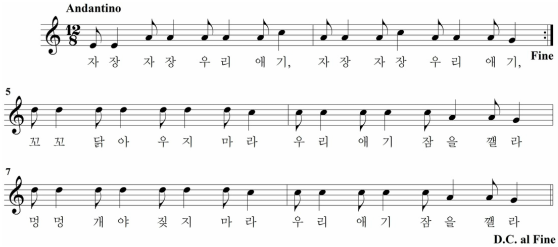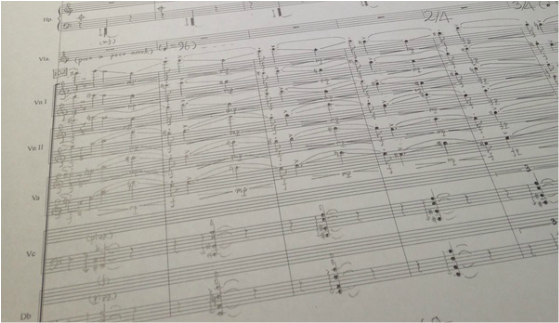Ko-Oh (2014)
Duration: 22 minutes
Instrumentation: 2(2+pic)2(2+eh)3(3=bcl)2/4221/tmp, 2pc, hp/solo viola/strings
Commissioner: Korean National Symphony Orchestra
Performance History
9/30/2015, Korean National Symphony Orchestra w/ Yura Lee (va) & Hun-Joung Lim (director), Zagreb, Croatia
10/2/2015, Korean National Symphony Orchestra w/ Yura Lee (va) & Hun-Joung Lim (director), Bratislava, Slovakia
10/4/2015, Korean National Symphony Orchestra w/ Yura Lee (va) & Hun-Joung Lim (director), Linz, Austria
6/6/2025, LA Phil w/ Yura Lee (va) & Hankyeol Yoon (conductor), Los Angeles, CA
Instrumentation: 2(2+pic)2(2+eh)3(3=bcl)2/4221/tmp, 2pc, hp/solo viola/strings
Commissioner: Korean National Symphony Orchestra
Performance History
9/30/2015, Korean National Symphony Orchestra w/ Yura Lee (va) & Hun-Joung Lim (director), Zagreb, Croatia
10/2/2015, Korean National Symphony Orchestra w/ Yura Lee (va) & Hun-Joung Lim (director), Bratislava, Slovakia
10/4/2015, Korean National Symphony Orchestra w/ Yura Lee (va) & Hun-Joung Lim (director), Linz, Austria
6/6/2025, LA Phil w/ Yura Lee (va) & Hankyeol Yoon (conductor), Los Angeles, CA
Program Note
In 2010, I read two interesting articles on lullabies. One asserted that the most effective way to induce sleep in babies is to play a recording of the heartbeat of their mothers. The other concerned a contest of lullabies (to see who could get babies to fall asleep the fastest) in Vienna, Austria, in the 1970s. The contest winner was a Korean folk lullaby sung by a Korean grandmother. Whether or not the articles were reliable, they were inspiring enough for me to compose a piece about them.
The actual composition process, however, did not begin until March 2014. That was when I heard that my father had cancer, a diagnosis that pushed me to complete the piece, hoping that my father could attend its premiere. I realize now that this piece is for my parents and their generation in South Korea – essentially everyone who deserves a quality rest after their arduous day.
My idea quickly expanded into becoming a pseudo-requiem – not a real one, which I would love to save for later. One may draw a parallel between sleep and death and, therefore, between lullaby and requiem. Coincidentally, the tragic sinking of the MV Sewol with hundreds of secondary school students occurred on April 16th, 2014, which led me to ponder the mystery of life and death further.
The overall structure of Ko-Oh reflects a daily cycle (night-day-night) or that of life (birth-life-death), with its symmetrical slow-fast-slow movement arrangement. In addition to the slow tempo, the first and the last movements typically have a handful of characteristics, such as their tonal center and iambic (short-long) rhythmic figuration. The latter is a shared feature of the heartbeat and the Korean lullaby, which are the significant inspirations of the first and last movements.
The first movement begins with repeated low drum sounds (heartbeats), which give birth to the breathing sound. From there, the solo viola part emerges and evolves into a quasi-improvisatory and exotic melody, foreshadowing the lullaby in the last movement. The nocturnal mood continues in the relatively more active middle section. Descending lines emerge from high, metallic sounds, like light from twinkling stars, and get interwoven complexly to culminate in turbulence. Towards the end, the long descending line of the solo viola gradually sinks back to the dark and calm beginning.
The frenetic second movement titled “busy, busy!!” is why we need a good rest: long, hectic days. It is full of ascending and descending scales and glissandi at various speeds, which could symbolize the entangled life. One might easily hear traces of the blues because I, to compose music meant to be comforting, immediately thought of incorporating elements from spiritual songs. At the end of all the dazzling twirls, the viola alone keeps dancing until falling into a faint.
The last movement features a Korean folk lullaby and its further variations. Like other lullabies, it is simple and comforting, with limited pitch material and a repeated rhythmic pattern. However, it can sometimes sound intense and expressive, which I also tried to incorporate into this movement. Ultimately, the solo viola plays the last phrase and fades completely alone, as if everyone else is sleeping.
Ko-Oh was written for the Korean National Symphony Orchestra while I was their composer-in-residence. It will be premiered by the same orchestra with violist Yura Lee and conductor Hun-Joung Lim on the 30th of September, 2nd of October, and 4th of October 2015, in Zagreb (Croatia), Bratislava (Slovakia), and in Linz (Austria), respectively. The viola would be the perfect center with its diverse expressive qualities. It can sound like a birdcall at nightfall, a girl forced to dance continually in her red shoes, or a grandmother's lullaby.
Ko-oh (코오) is a Korean baby talk word meaning "sleep." Below is the transcription of the original Korean lullaby with its English translation.

Sleep, sleep, our baby.
Sleep, sleep, our baby.
Don’t cluck, chickens,
Our baby might get awake.
Don’t bark, puppies,
Our baby might get awake.
close program note
In 2010, I read two interesting articles on lullabies. One asserted that the most effective way to induce sleep in babies is to play a recording of the heartbeat of their mothers. The other concerned a contest of lullabies (to see who could get babies to fall asleep the fastest) in Vienna, Austria, in the 1970s. The contest winner was a Korean folk lullaby sung by a Korean grandmother. Whether or not the articles were reliable, they were inspiring enough for me to compose a piece about them.
The actual composition process, however, did not begin until March 2014. That was when I heard that my father had cancer, a diagnosis that pushed me to complete the piece, hoping that my father could attend its premiere. I realize now that this piece is for my parents and their generation in South Korea – essentially everyone who deserves a quality rest after their arduous day.
My idea quickly expanded into becoming a pseudo-requiem – not a real one, which I would love to save for later. One may draw a parallel between sleep and death and, therefore, between lullaby and requiem. Coincidentally, the tragic sinking of the MV Sewol with hundreds of secondary school students occurred on April 16th, 2014, which led me to ponder the mystery of life and death further.
The overall structure of Ko-Oh reflects a daily cycle (night-day-night) or that of life (birth-life-death), with its symmetrical slow-fast-slow movement arrangement. In addition to the slow tempo, the first and the last movements typically have a handful of characteristics, such as their tonal center and iambic (short-long) rhythmic figuration. The latter is a shared feature of the heartbeat and the Korean lullaby, which are the significant inspirations of the first and last movements.
The first movement begins with repeated low drum sounds (heartbeats), which give birth to the breathing sound. From there, the solo viola part emerges and evolves into a quasi-improvisatory and exotic melody, foreshadowing the lullaby in the last movement. The nocturnal mood continues in the relatively more active middle section. Descending lines emerge from high, metallic sounds, like light from twinkling stars, and get interwoven complexly to culminate in turbulence. Towards the end, the long descending line of the solo viola gradually sinks back to the dark and calm beginning.
The frenetic second movement titled “busy, busy!!” is why we need a good rest: long, hectic days. It is full of ascending and descending scales and glissandi at various speeds, which could symbolize the entangled life. One might easily hear traces of the blues because I, to compose music meant to be comforting, immediately thought of incorporating elements from spiritual songs. At the end of all the dazzling twirls, the viola alone keeps dancing until falling into a faint.
The last movement features a Korean folk lullaby and its further variations. Like other lullabies, it is simple and comforting, with limited pitch material and a repeated rhythmic pattern. However, it can sometimes sound intense and expressive, which I also tried to incorporate into this movement. Ultimately, the solo viola plays the last phrase and fades completely alone, as if everyone else is sleeping.
Ko-Oh was written for the Korean National Symphony Orchestra while I was their composer-in-residence. It will be premiered by the same orchestra with violist Yura Lee and conductor Hun-Joung Lim on the 30th of September, 2nd of October, and 4th of October 2015, in Zagreb (Croatia), Bratislava (Slovakia), and in Linz (Austria), respectively. The viola would be the perfect center with its diverse expressive qualities. It can sound like a birdcall at nightfall, a girl forced to dance continually in her red shoes, or a grandmother's lullaby.
Ko-oh (코오) is a Korean baby talk word meaning "sleep." Below is the transcription of the original Korean lullaby with its English translation.

Sleep, sleep, our baby.
Sleep, sleep, our baby.
Don’t cluck, chickens,
Our baby might get awake.
Don’t bark, puppies,
Our baby might get awake.
close program note
